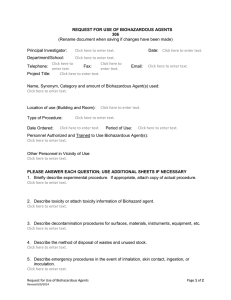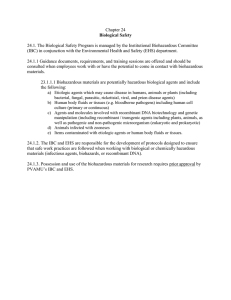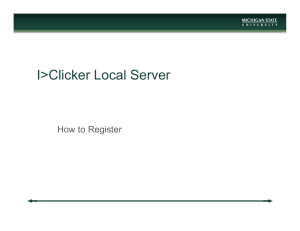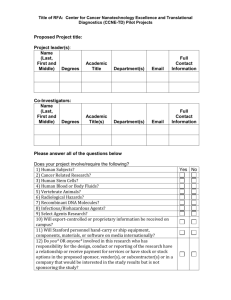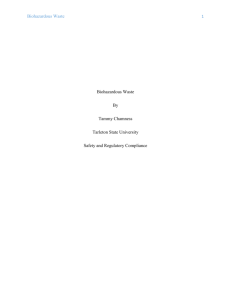Biohazardous Waste Management Plan Michigan State University
advertisement
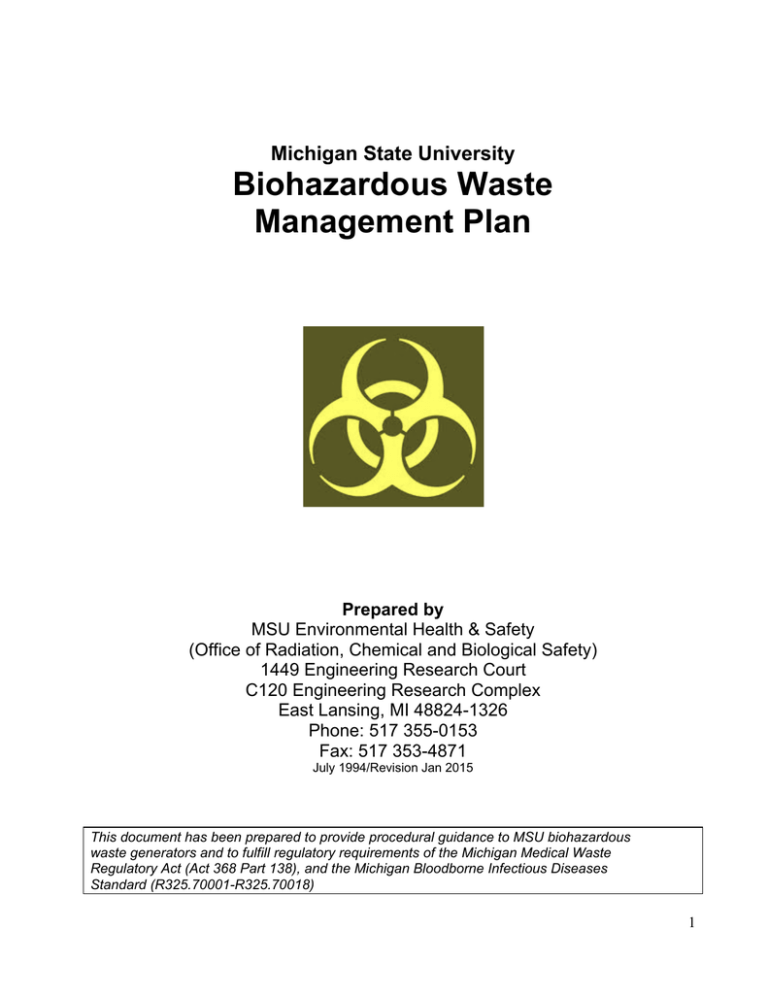
Michigan State University Biohazardous Waste Management Plan Prepared by MSU Environmental Health & Safety (Office of Radiation, Chemical and Biological Safety) 1449 Engineering Research Court C120 Engineering Research Complex East Lansing, MI 48824-1326 Phone: 517 355-0153 Fax: 517 353-4871 July 1994/Revision Jan 2015 This document has been prepared to provide procedural guidance to MSU biohazardous waste generators and to fulfill regulatory requirements of the Michigan Medical Waste Regulatory Act (Act 368 Part 138), and the Michigan Bloodborne Infectious Diseases Standard (R325.70001-R325.70018) 1 Michigan State University Biohazardous Waste Management Plan TABLE OF CONTENTS Section Page INTRODUCTION GENERAL PROGRAM MANAGEMENT • Areas of Responsibility • Biohazardous Waste Management Plan Availability BIOHAZARDOUS WASTE AT MSU • Types of Biohazardous Waste Generated and/or Handled On Campus • Segregation, Packaging, Labeling and Collection methods • Methods of On-Site or Off-Site Storage • Methods of On-site or Off-site Decontamination EXPOSURE MINIMIZATION METHODS FOR EMPLOYEES • Biohazardous Waste Training 3 4 4 5 5 5 6 7 8 8 9 APPENDICIES APPENDIX A • MSU On-Campus Facilities • MSU Off-Campus Facilities APPENDIX B • Michigan Medical Waste Regulatory Act 1990 10 10 10 11 11 2 Introduction At Michigan State University, the term biohazardous waste is used to describe different types of waste that might include infectious agents. Currently, the following waste categories are considered to be biohazardous waste and are covered by the provisions of the MSU Biohazardous Waste Management Plan: • Medical Waste: Defined as any solid waste which is generated in the diagnosis, treatment, (e.g. provision of medical services), or immunization of human beings in research and healthcare pertaining thereto, or in the production or testing of biologicals, as well as categories defined by the Michigan Medical Waste Regulatory Act (MMWRA). According to the MMWRA, medical waste includes: 1. Cultures and stocks of infectious agents and associated biologicals, including laboratory waste, biological production waste, discarded live and attenuated vaccines, culture dishes, and related devices. 2. Liquid human and animal waste, including blood and blood products and body fluids, but not including urine or materials stained with blood or body fluids. 3. Pathological waste: defined as human organs tissues, body parts other than teeth, products of conception, and fluids removed by trauma or during surgery or autopsy or other medical procedure, and not chemically-fixed (i.e. formaldehyde). 4. Sharps: defined as needles, syringes, scalpels, and intravenous tubing with needles attached regardless of whether they are contaminated or not. 5. Contaminated wastes from animals that have been exposed to agents infectious to humans, these being primarily research animals. • Regulated waste as defined by the Michigan Occupational Safety Health Administration (MIOSHA) Bloodborne Infectious Diseases Standard including: 1. Liquid or semi-liquid blood or potentially infectious materials; 2. Contaminated items that would release blood or other potentially infectious materials in a liquid or semi-liquid state if compressed; 3. Items that are caked with dried blood or other potentially infectious materials and are capable of releasing these materials during handling; 4. Contaminated sharps which includes any contaminated object that can penetrate the skin; 5. Pathological and microbiological wastes containing blood or other potentially infectious materials. • Laboratory waste and regulated waste as defined in the NIH Guidelines for Research Involving Recombinant or Synthetic Nucleic Acid Molecules and the CDC/NIH Biosafety in Microbiological and Biomedical Laboratories. In general, this category includes contaminated waste that is potentially infectious and/or hazardous to humans, animals or plants. MSU requires that all employees involved in the generation, handling and disposal of biohazardous waste comply with the provisions of the Biohazardous Waste Management Plan. The plan was prepared by the Environmental Health & Safety (EHS) and is used in conjunction with the MSU Hazardous Waste Disposal Guide. The plan encompasses the general provisions for all MSU facilities (on or off-campus). However, the main document addresses the types of waste and practices used by on-campus facilities only. 3 Specific information regarding the types of wastes generated and practices used by off-campus facilities may be found in the appendices or by contacting EHS at 355-0153. General Program Management Areas of Responsibility The proper segregation, treatment and disposal of biohazardous waste can only be achieved through the cooperation of all responsible MSU personnel. This division of responsibilities includes: 1. The Environmental Health and Safety (EHS); specifically the Hazardous Waste Coordinator and the Biological Safety Officer or their designee; (refer to Appendix A) 2. Supervisory Personnel (including Department Chairs, Directors, Principal Investigators, Managers and Supervisors); 3. Employees. EHS The Hazardous Waste Coordinator and Biological Safety Officer or their designee will: • • • Oversee the implementation of the Biohazardous Waste Management Plan; Develop, in coordination with administrators, additional biohazardous waste-related policies and procedures as needed to support the effective implementation of this plan and maintain compliance with regulatory requirements; Revise the plan each time there is a change in either of the following, within 30 days after the change occurs: a. A person or site named in the plan; b. The type of waste handled, or the methods of handling waste at a facility. Supervisory Personnel Supervisory personnel are responsible for compliance in their areas. In cooperation with the EHS, supervisory personnel must: • • Assure that all employees who generate, handle, treat and/or dispose of biohazardous waste receive biohazardous waste training as outlined below; Assure that all employees under their supervision who generate, handle, treat and/or dispose of biohazardous waste follow the procedures outlined in this document. Employees Employees who generate, handle, treat, and/or dispose of biohazardous waste are responsible for: • • Following the procedures and practices outlined in this document; Participate in a biohazardous waste training session. 4 Biohazardous Waste Management Plan Availability Upon request, MSU will make the Biohazardous Waste Management Plan available to the Michigan Department of Environmental Quality (DEQ). The Biohazardous Waste Management Plan will be available to MSU employees. Employees can request a hard copy of the plan by calling the EHS at 355-0153. A hard copy will be provided to the requesting employee within 24 hours of receipt of the request. The latest revision of the MSU Biohazardous Waste Management Plan will be available on the EHS website (www.ehs.msu.edu). Biohazardous Waste at MSU Types of Biohazardous Waste Generated and/or Handled On Campus At Michigan State University the following types of biohazardous waste may be generated and/or handled: 1. Cultures and stocks of infectious agents and associated biologicals, including laboratory waste, biological production wastes, discarded live and attenuated vaccines, culture dishes, and related devices. 2. Liquid human and animal waste, including blood and blood products and body fluids, but not including urine or materials stained with blood or body fluids. 3. Pathological waste including human organs, tissues, body parts other than teeth, products of conception, and fluids removed by trauma or during surgery or autopsy or other medical procedure. 4. Sharps, which means needles, syringes, scalpels, intravenous tubing with needles attached; any item that is sharp enough to penetrate the skin and is contaminated with potentially infectious material. 5. Contaminated wastes from animals that have been exposed to agents infectious to humans or animals, these being primarily research animals. 6. Wastes generated in recombinant or synthetic nucleic acid molecules research. 7. Animal carcasses and wastes (i.e. bedding) that have been generated in infectious disease research or recombinant DNA or synthetic nucleic acid molecules research. Refer to the MSU Hazardous Waste Disposal Guide for information regarding disposal of animal carcasses generated in other types of research. 5 Segregation, Packaging, Labeling and Collection of Biohazardous Waste at MSU At Michigan State University the following procedures are used for segregation, packaging, labeling and collection of medical waste. General methods 1. All biohazardous waste is to be packaged, contained and located in a manner that prevents and protects the medical waste from release at the producing facility at any time before ultimate disposal. 2. All primary containers (other than biohazard bags) used for medical waste collection, storage and disposal are to be labeled with a biohazard symbol, or the words "Medical Waste", or "Pathological Waste" in letters not less than one inch high. The required background color of all primary containers is red or orange fluorescent (e.g., biohazard bags). 3. All waste containers that are picked up by the EHS should be labeled with a MSU Materials Pick Up Tag (Waste tag) in accordance with the MSU Hazardous Waste Disposal Guide. Waste Type-Specific Management Methods 1. All liquid cultures and stocks of materials contaminated with an infectious agent and associated biologicals, including laboratory waste, biological production wastes, discarded live and attenuated vaccines, shall be stored in closable, puncture-resistant containers and decontaminated by autoclaving or chemically treated. After autoclaving or chemically treating liquid decontaminated waste can be disposed of in a sanitary sewer if no other hazardous materials are present (e.g., chemicals and/or radioactive materials). For information on the special treatment of radioactive biohazardous waste, contact the EHS at 355-0153. 2. All solid cultures and stocks of materials contaminated with an infectious agent, culture dishes and related devices other than sharps, can be stored in leak-proof, biohazard bags prior to decontamination. If rupture of bags, or leakage is possible, the use of a secondary leak-proof container or bag is advised. 3. Solid biohazardous waste, excluding sharps, that have been decontaminated by autoclaving, may be disposed of in the lodal (dumpster) if they are securely packaged in leak-proof containers and the biohazard warning labels have been removed or the container is clearly labeled as decontaminated biohazardous waste. Decontaminated waste in biohazard bags with an "Autoclaved" bag indicator must be placed inside a nonsee-through (opaque) plastic bag or other secondary non-transparent container (box) prior to disposal in the lodal. It is imperative that the waste is sufficiently autoclaved (darkening of the indicator) prior to disposal. Only biohazard bags with the "AUTOCLAVED" indicator are currently approved by MSU. These bags are available from MSU University Stores or MSU Biochemistry Stores. 6 4. All blood and blood products and body fluids shall be disposed of by one of the following methods: • • Flushing down a sanitary sewer; Decontaminated by autoclaving and disposed of in the landfill. 5. Human pathological waste shall be cremated or buried in a cemetery. Small pieces of tissue and fluids shall be ground until rendered unrecognizable and flushed down a sanitary sewer or incinerated. For disposal of animal waste (carcasses or tissue), refer to the MSU Hazardous Waste Disposal Guide. 6. Sharps shall be disposed of by a certified waste hauler. Place discarded needles and syringes into an approved MSU sharps container. An approved sharps container is one that is leakproof, puncture-resistant, closable, bears the biohazard symbol and is manufactured as a sharps container. Sharps containers used on campus should also be labeled with the EHS “SHARPS” label to facilitate proper treatment and disposal of containers. Do not clip, bend, break, or recap sharps. A sharps container must be permanently closed and disposed of through the EHS when: • • It is ¾ full, or Within 90 days of the date that the first sharp was placed in it, whichever comes first. For pick-up request, refer to the MSU Hazardous Waste Disposal Guide. 7. Animal waste contaminated with organisms infectious to humans shall be collected in biohazard bags or other leak-proof containers labeled with a biohazard sticker and disposed of by incineration. 8. Animal carcasses generated in infectious disease research or recombinant or synthetic nucleic acid molecule research will be stored in leak-proof containers labeled with a biohazard sticker and disposed of by incineration. 9. Wastes generated in recombinant or synthetic nucleic acid molecule research will be stored, treated and disposed of in the same manner as comparable waste types (i.e. liquid, solid, sharps) generated in infectious disease research. Methods of On-Site or Off-Site Storage Biohazardous waste cannot be stored on the premises for more than 90 days. All containers and equipment (e.g., refrigerators) used for storage shall be labeled with the biohazard sticker or the words medical waste, or pathological waste in letters not less than one inch high. The preferable background color of all primary medical waste containers is red or orange fluorescent (e.g., biohazard bags). 7 Methods of On-site or Off-site Decontamination Decontamination by Autoclave Biohazardous waste, other than sharps and pathological waste, may be decontaminated on-site by autoclaving. To use this on-site treatment method, personnel must use an autoclave that has been tested and approved through EHS for biohazardous waste decontamination. Approved autoclaves are labeled with a large colored sign located on or near the autoclave. The colored sign will also list operating parameters for effective waste decontamination for that specific autoclave. These parameters must be followed by all personnel using the autoclave for waste decontamination purposes. The EHS tests all autoclaves used for waste decontamination on at least an annual basis to verify that operating parameters used for waste treatment are sufficient and effective for biohazardous waste decontamination. For more information, contact the EHS at 355-0153. On-site Incineration On-site incineration is conducted by the Environmental Health and Safety (EHS). For more information regarding incineration, contact the EHS at 355-0153. Corporate or other legally recognized business name of solid waste haulers who transport medical waste for the producing facility Currently MSU is utilizing: Stericycle of Grand Rapids 2695 Elmridge Dr NW #B Grand Rapids, MI 49534-1302 (616) 791-2140 (866) 783-7422 Use of Sanitary Landfills, Cemeteries and Other Disposal Sites All autoclaved and decontaminated biohazardous waste will be disposed of in a Type II Sanitary Landfill. Exposure Minimization Methods for Employees Involved in Biohazardous Waste Generation, Handling and Disposal In accordance with MIOSHA regulations, Michigan State University has implemented an Exposure Control Plan (ECP) for Bloodborne Pathogens. The ECP covers the areas of protocols, procedures, and training, personal protective devices and clothing, physical containment or isolation devices or systems, and prevention or control of aerosols regarding bloodborne pathogens. 8 Michigan State University has developed a Biosafety Manual outlining necessary procedures and practices involving infectious agent research and recombinant or synthetic nucleic acid molecule requirements. Other training programs to meet the needs of personnel who may not receive information on this topic through routine EHS training programs (i.e. chemical hygiene training, bloodborne pathogens training) are available. Biohazardous Waste Training All personnel who generate, handle or dispose of biohazardous waste must complete training in the provisions of this plan. The training topics will include: • • • • Purpose and overview of the MSU Biohazardous Waste Management Plan; Types of biohazardous waste generated, treated or disposed of at the work site; Segregation, packaging, storage and transport of biohazardous waste that is generated, treated or disposed of at the work site; Treatment and disposal methods for biohazardous waste that is generated, treated or disposed of at the work site. In accordance with the Michigan Medical Waste Regulatory Act, new personnel must complete biohazardous waste training before they assume duties that involve the handling of biohazardous waste. Employees will receive updated information when a change in the Biohazardous Waste Management Plan occurs that directly affects their duties. Training Records The EHS will maintain training records for all on-campus personnel completing biohazardous waste training. Off-campus site coordinators will maintain training records for their facilities. These records will include: • • • Employee’s name Job classification Training date All training records will be maintained for a minimum of three years. 9 APPENDICES Appendix A MSU On-Campus Facilities Management: Hazardous Waste Coordinator, EHS, Brian Smith Biological Safety Officer, EHS, Jamie Willard-Smith, PhD For information regarding the management of biohazardous waste at MSU on-campus facilities, contact the EHS at 355-0153. Incineration: Environmental Compliance Officer, EHS, Tom Grover For information regarding on-site incineration, contact Tom Grover at 355-6651. Types of Biohazardous Waste: As outlined in the MSU Biohazardous Waste Management Plan Methods of storage, treatment and disposal: As outlined in the MSU Biohazardous Waste Management Plan MSU Off-Campus Facilities Clinic/Facility Address City/State Waste Hauler Okemos Pediatric Clinic 1600 W. Grand River Ave., Ste. 2 Okemos, MI 48864 Environmental Health & Safety Westside Pediatric Clinic 7335 Westshire Dr., Ste. 102 Lansing, MI 48917 Environmental Health & Safety Dewitt Pediatric Clinic 13750 S. Sedona Pkwy., Ste. 2 Lansing, MI 48906 Environmental Health & Safety MSU Hematology/ Oncology Clinic (Breslin Cancer Center) 401 W. Greenlawn Ave Lansing, MI 48910 McLaren (Uses Stericycle, Inc.) MSU Center for Orthopedic Research 2727 S. Pennsylvania Ave., Ste. 209 Lansing, MI 48910 McLaren (Uses Stericycle, Inc.) 10 Musculoskeletal Rehabilitation Clinic 2815 S. Pennsylvania Ave., Ste. 2 Lansing, MI 48910 Environmental Health & Safety MSU Urology Clinic 2900 Hannah Blvd., Ste. 104 E. Lansing, MI 48823 Environmental Health & Safety MSU Sports Medicine Clinic 4660 S. Hagadorn E. Lansing, MI Rd., Ste. 420 48823 Environmental Health & Safety MSU Surgery 1200 E. Michigan Ave., Ste. 655 Lansing, MI 48912 Environmental Health & Safety MSU Women’s Healthcare Clinic 1200 E. Michigan Ave., Ste. 700 Lansing, MI 48912 Environmental Health & Safety Pediatric Sub-specialty Clinics 1200 E. Michigan Ave., Ste. 145 Lansing, MI 48912 Environmental Health & Safety MSU Spine Center 4660 S. Hagadorn East Lansing, MI Rd., Ste. 500 48823 Environmental Health & Safety Physical Medicine & Rehabilitation Clinic 1200 E. Michigan Ave., Ste. 520 Lansing, MI 48912 Environmental Health & Safety MSU Rehabilitation Clinic 4660 S. Hagadorn East Lansing, MI Rd., Ste. 420 48823 Environmental Health & Safety Osteopathic Manipulative Medicine 4660 S. Hagadorn East Lansing, MI Rd., Ste. 500 48823 Environmental Health & Safety Women’s Imaging Center 4660 S. Hagadorn East Lansing, MI Rd., Ste. 600 48823 Environmental Health & Safety Kellogg Biological Station - MSU 3700 E. Gull Lake Dr. Hickory Corners, MI 49060 Environmental Health & Safety MSU Research Labs at Van Andel Research Inst. 303 Bostwick NE Grand Rapids, MI 49503 Environmental Health & Safety Appendix B: Michigan Medical Waste Regulatory Act 1990 http://www.michigan.gov/documents/deq/whm-stsw-mwrp-MW-Reg-ActRules_257176_7.pdf 11
